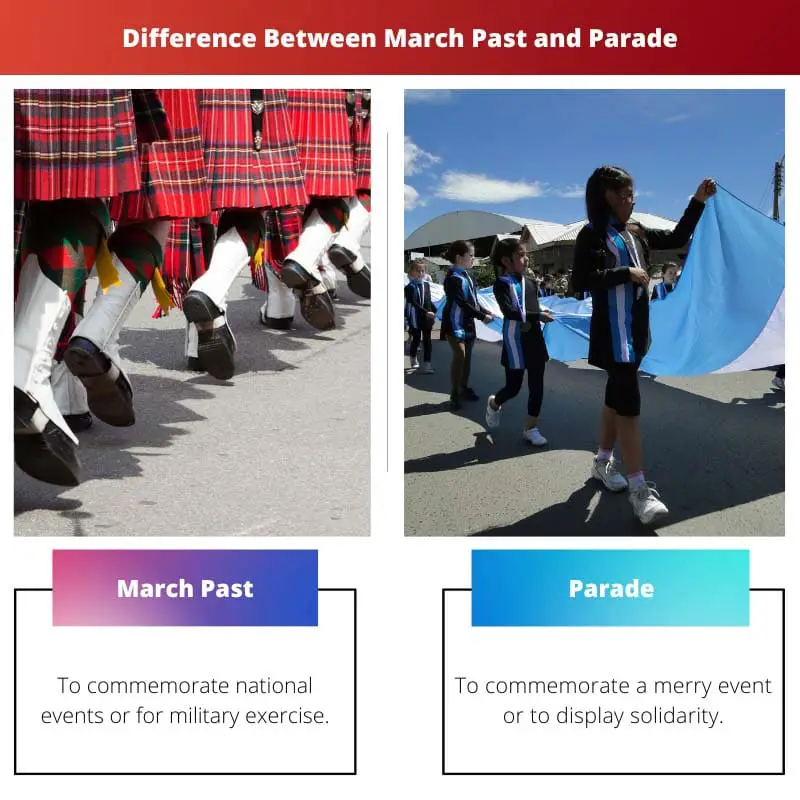Various methods demonstrate and exhibit team spirit and form communal bonds. The two most common methods are March Past and Parade.
Both seem similar but have distinguishable differences and features. The team combination and the discipline in both methods are distinctly different from each other.
Key Takeaways
- A march past is a formal military procession where troops march in formation, as part of a ceremonial event or to display discipline and unity.
- A parade is a festive public procession that can include various elements, such as marching bands, floats, and performers, held to celebrate a specific occasion or event.
- Both march pasts and parades involve organized processions, but march pasts focus on military discipline and formation, while parades encompass a broader range of celebratory elements.
March Past vs Parade
A march past is a regular and measured tread, where a group of people, soldiers, walk past a place or person of importance. A parade, on the other hand, is a public procession celebrating a special day or event, involving music, floats, and elaborate displays.

March past is not conducted for the entertainment of the audience. It is either for the exercise of military troops or can even be conducted at any national event. March Past does not have any political incorporation and is not conducted for any protest.
While the parade is conducted for the entertainment of the audience, it has a particular theme on which the entire parade is decorated, and costumed individuals present choreographed performances on the same theme.
The parade is also associated with protests. It can have the incorporation of politics.
Comparison Table
| Parameters of Comparison | March Past | Parade |
|---|---|---|
| Type | Military affair | Public procession |
| Purpose | To commemorate national events or for military exercise | To commemorate a merry event or to display solidarity |
| Participants | In March past, a group of military personnel are involved | In the parade, there can be a group of like-minded people and costumed entertainers and performers |
| Audience | March past is not done for any audience or spectators | Parade is exclusively done for the entertainment of audience or spectators |
| Synchronization | March past is a disciplined movement and involves high synchronization | Parade may or may not involve synchronization, depending upon the theme of the parade |
What is March Past?
March past is referred to an organized and uniformed marching by military troops. It involves steady walking in the forward movement, either route-step time or rhythmic type.
March Past is associated primarily with civilian and military ceremonial parades. It forms a primary structure in the basic training of the military. It involves a specific system and set of drill commands in most countries.
In March Past, the main idea is to teach a soldier to march to the cadences of martial drum music and the commands. Four basic components have to be maintained by the individuals during rhythmic marching.
They are dress, cover, interval, and distance, also termed as DCID. March past is also a provocative ritual in various places.
March past is a symbol of control over a specific area and is considered a sectarian activity. Marches can be divided into various types depending on the pace and steps.
Like the quick march, the double march, the highland march, the Slow march, the rifles march, the French Foreign Legion pace, the parade march, and the Paso Legionario, the occurrence of each step is on each beat.
In March, the term pace was used to determine the length of one step. The ideal pace is around 75 centimetres or 30 inches. During marching, the opposite arms swing with the leg to provide mechanical efficiency.
However, various armed forces also keep their arms straight, and the hand is swung as high as the shoulder.

What is a Parade?
A parade is referred to as a public procession that is organised along a street. Costumed individuals, floats, and huge balloons accompany it.
The cause of parades can be divorce, but it is to celebrate some event. Various protest demonstrations can also be conducted in the form of parades.
Parades can be conducted for various annual events like Independence Day, Bastille Day Military Parade, Calgary Stampede Parade, Easter Parade, Mardi Gras, and others.
There are various types of parades like carnival parades, flower parades, boat parades, pride parades, cavalcades, techno parades, circus, victory parades, bypassed, Halloween parades, a parade of nations, Santa Claus parades, a parade of horribles, motorcade, ticker-tape parade, walking day and various others.
Designation of several grand marshals is done for parades. Hanover Schützenfest is the longest parade that is conducted in Hanover every year.
The length of this parade is around 12 kilometres, and it has over 12,000 participants from all over the world. It is accompanied by 70 floats, 100 bands, and numerous carriages.
A parade float is also conducted occasionally. Initially, it was held by the parade marchers on the sure. But recently, parade floats are either powered themselves or are pulled by motor vehicles.
The technique of propelling by concealed oarsmen was abandoned due to the high risk of drowning. With the incorporation of technology, aerial parade and sail-past are also common phenomena.

Main Differences Between March Past and Parade
- March Past is not theme-based, while a parade is conducted on a particular theme.
- Specific marching bands accompany March Past, while a parade is accompanied by various music and audio.
- March Past does not involve any costumed individuals, while a parade involves costumed individuals performing choreographed steps.
- March past does not allow the participation of celebrities or common people, while celebrities or common people can conduct parades.
- March Past is conducted at various national events or as an exercise for the military, while the parade is conducted to celebrate a joyous event or to exhibit solidarity with the public.

- https://search.proquest.com/openview/7fb3be063c597fa325aa868cb25e9679/1?pq-origsite=gscholar&cbl=1817043
- https://www.ajkd.org/article/S0272-6386(14)70005-8/abstract
